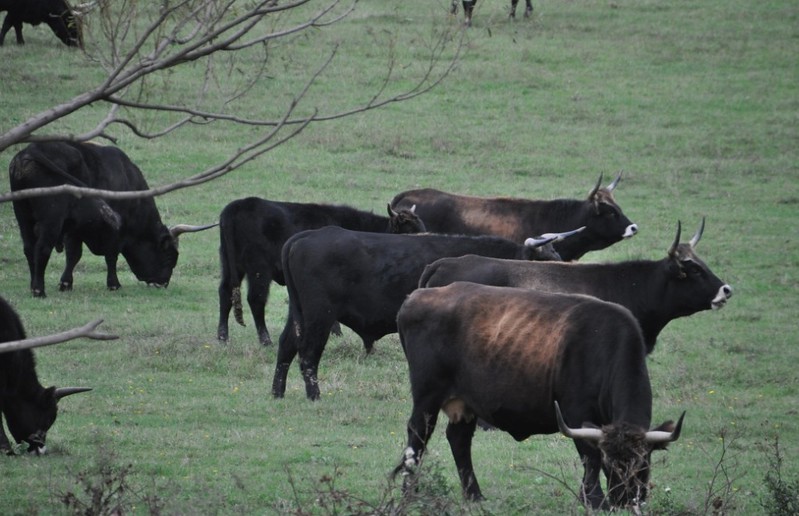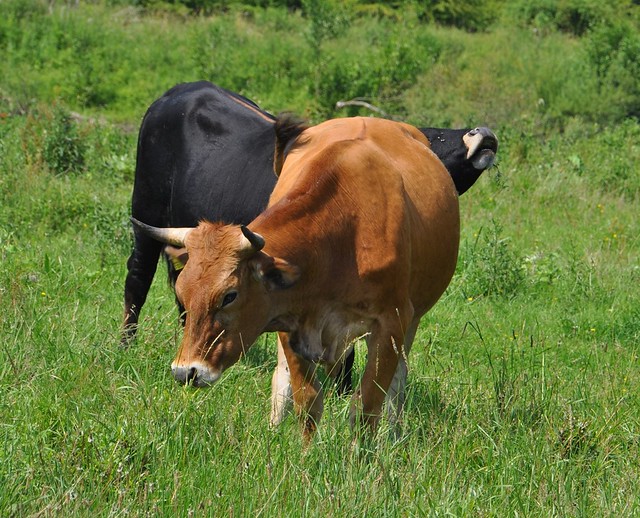The upper photo is from Hortobagy (© Istvan Sandor) and shows the breeding bull Rimu with a cow. The lower photo shows two Taurus individuals from the Lippeaue. As you see the colour difference between bull and cow is very strong on these photos, but do not fall into the pitt concluding that these photos automatically show good sexual dichromatism - it is not said that both individuals are closely related and inherit the sexual dichromatism that we want in these cattle. Their genotype is very heterogeneous and we cannot know for sure. That is why we should always look at the tendency in the total population, and I did this for the Lippeaue anno 2015.
In my post
on the genetic and developmental background of morphological traits, I outlined
that it might be very difficult to impossible to achieve an authentic aurochs-like
sexual dimorphism, in particular sexual dichromatism (the colour difference
between the sexes), based on conventional phenotypic selection:
Always simply choosing red cows and dark bulls,
or small cows and large bulls, or whatever sexually dimorphic trait, probably
will work not here. You would actually have to choose individuals where the
sexual dimorphism is laid down in the genome. A phenotypically red cow
might either have a more or less strong sexual dichromatism (s. dimorphism in
colour), or simply be red and have no sexual dichromatism at all, depending on
the bulls that she would produce. The same is the case with dark bulls. How to
know that? Well, at first the genetic background of the dimorphic trait has to
be resolved, and then the individuals would have to be tested.
So not only
would the auto- and gonosomal genes and alleles involved in sexual dichromatism
have to be identified, each individual would have to be genetically tested.
This would be very expensive and requires research. Therefore I concluded:
I think there are only two possibilities
regarding breeding a good sexual dimorphism: either relying heavily on a breed
where a well-marked sexual dimorphism is still retained […], or putting up with
the fact that there will always be a certain number of cow-coloured bulls and
bull-coloured cows
Nevertheless,
this does not have to mean that the extent of sexual dichromatism cannot reach
a satisfying level. I am going to have a brief look at some cases of
breeding-back populations with a satisfying level of sexual dichromatism, and
go deeper into my usual case-study herd of Taurus cattle at the Lippeaue in
Germany.
As a brief
reminder: standard “aurochs bull colour” is to be considered black with the
exception of a dorsal stripe and a muzzle ring, the area on the back can also
have a slight brownish tint but it is unlikely that European aurochs bulls
possessed a so-called colour saddle. The full colour spectrum of the forelocks
is unknown. “Cow colour” probably includes all shades of reddish brown to
darker until black with a colour saddle or completely “bull coloured”. But
those black cows were, according to written sources, very rare. For details,
have a look at my previous post.
Sexual
dichromatism in existing breeding-back populations
For the
case of the Tauros and Auerrind Project, the time is surely to early now to
judge sexual dichromatism yet – the gene pool is not mixed enough yet in the
case of the Tauros Project, and the Auerrind Project is just getting started. For
Taurus cattle, I pick the Lippeaue as an example but serve that for later. So
what is left is Heck cattle for now.
Heck cattle
are very heterogeneous in regards to sexual dichromatism, as they are in regards
to all traits. In some herds, one has to conclude that there is little to no
dichromatism at all (many bull-coloured cows, many bulls with a colour saddle).
In many herds, there is a tendency of the cows being coloured lighter than the
bulls but still contain many variations. In some Heck herds and lineages,
however, a quite satisfying level of sexual dichromatism has been achieved. One
good example is the herd at Hellabrunn zoo, Munich, at least when I visited it
in 2011.
The
Neandertal lineage has a satisfying level of sexual dichromatism as well. Many
cows show the reddish-brown colour I we see in cave paintings. There are black
ones too, of course. Both the Hellabrunn herd and the Neandertal lineage have a
very good colour, very intense and seemingly cleared of dilution alleles (there
have been no diluted individuals from these lineages for quite some time).
Another herd with a good amount of sexual dichromatism that I know of is the
one at the Lainzer Tiergarten at Vienna. But in a different way: there are no
cows that can be considered “of a reddish-brown colour”, but the type with the
dark base colour and the light colour saddle/back is prevalent instead. There were
almost no black cows in the herd and no bulls with saddles when I last had a
look at the herd in 2014. Another Heck
herd that I visited that also had a quite good colour is the herd at Tierpark
Haag, Lower Austria, but the number of the individuals was so small that the
gene pool cannot really be judged properly with only a handful of individuals.
 |
| The dimorphism in the Lainzer Tiergarten herd is good as well |
So where
did those Heck herds get their good dichromatism from? Of the founding breeds
of Heck cattle, Corsican cattle is best in regards to colour in general and
sexual dichromatism. The breed left a strong mark in Heck cattle’s phenotype,
which is also not surprising since Heinz Heck relied heavily on crossed
individuals with a high portion of Corsican cattle. And the comparably careful
selection in both the Munich zoo and the Wildgehege Neandertal probably kept
the genes responsible for good dichromatism abundant in those lineages compared
to other Heck herds (which often turned into a bit of a “phenotypical mess”).
The sexual
dichromatism in the Lippeaue
Taurus
cattle is, just like Heck cattle, a mosaic population that is heterogeneous in
appearance and instable in inheritance yet. This is not surprising as there are
still some first-generation crosses in the herd, the youngest individuals are
of the 7th generation already. Taurus cattle is heterogeneous, but one
could still determine whether there is a tendency to sexes having different
colours or whether the inheritance of colours is independent from sex. In order
to determine that tendency, I decided to count the individuals and note their
colour, and distribution among the sexes. I made two categories for the sexes
respectively: for bulls, “bull colour” as defined above and anything that is
less eumelanisized than that (so either a prominent colour saddle or reddish
brown colour overall) and for cows either “bull colour” (or black, if you will;
except for the light markings of course) and anything lighter coloured than
that (so either black with a saddle, or the various shades of reddish brown).
Some individuals show diluted colours where the red pigment is reduced.
However, the amount of sexual dichromatism is determined by black pigment, so I
counted those diluted animals with reduced red pigment but not the
half-Chianina individuals (neither bulls nor cows) which have a semi-dominant
dilution that reduces black pigment, what makes them not comparable. I counted
the individuals in their summer coat, as the winter coat is often darker than
the summer coat and a saddle might disappear that is otherwise present.
I used a
photo archive I was provided by Matthias Scharf that showed all individuals
present in the herd in the year 2015 on several clear photos. I counted only
individuals that already had their adult colour, so no calves. Usually it would
be problematic that only the breeding bulls are kept till full age, but luckily
they kept a lot of young bulls with their adult colour until fall 2015 when
they were either sold or slaughtered.
These are
the results:
Total
number: 71
Bulls total
: 25
Bulls
black: 22 (88%)
Bulls with
a saddle*: 3 (12%)
* There
where no reddish-brown bulls, and from what I know usually such bulls do not
appear in the Lippeaue, except for half-Chianina individuals.
Cows total:
46
Cows “cow
coloured”: 39 (85%)
Cows black:
7 (15%)
We should expect those numbers to fluctuate slightly with each year, and are of course dependent on the "selection policy" in the Lippeaue. But this should be a number that can be worked with. In my
opinion, this is a quite satisfying degree of sexual dichromatism. In the past,
I have been wondering what would be the minimum point from which on the sexual
dichromatism can be considered satisfying, and I concluded that no bulls with
saddles and only 5-10% black cows would be satisfying to me. The amount of
dichromatism in the Lippeaue comes comparably close. The question is if
phenotypic selection could increase it any further in this case. I think it
would be difficult. But to me, the level of dichromatism in the Lippeaue is
satisfying. It would be interesting to do the same evaluation for other herds,
such as Heck herds with good dimorphism (f.e. Neandertal or Hellabrunn) and
such with very low dimorphism. Perhaps this level of sexual dichromatism would
also be found in a lot of other herds of Taurus and Heck cattle. It will be
very interesting to compare it with future herds of the Tauros Project and
Auerrind project that work with different breeds.
Where did
the Lippeaue population get its good dichromatism from? Sayaguesa has almost no
sexual dichromatism, so probably not that breed. Most likely it is thanks to
the Heck cattle from the Neandertal lineage that were the base of the herd in
the 1990s. It is also plausible that Chianina inherits some degree of sexual
dichromatism masked beneath their colour dilutions, as Sayaguesa x Chianina
cows tend to be of a much lighter colour than bulls of the same combination.




No comments:
Post a Comment